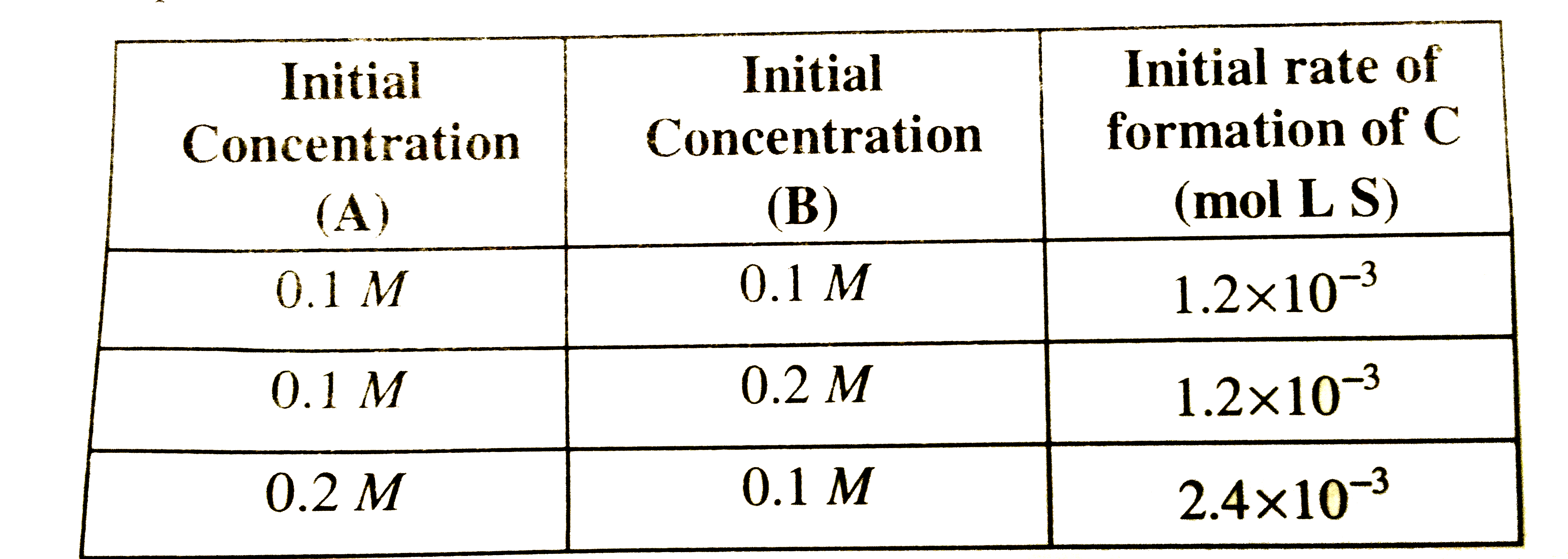For the non-stoichiometric reaction :
2 A+B → C+D , the following kinetic data were obtained in three separate experiments all at 298 K

The rate law for the formation of C is
dCdt=k[A]
dCdt=k[A][B]
dCdt=k[A]2[B]
dCdt=k[A][B]2
The correct Answer is:A
Rate of reaction = Rate of formation of C(dCdt)
Suppose, rate of reaction =k[A]α[B]β
Then 1⋅2×10−3=k(0⋅1)α(0⋅1)β …(i)
1⋅2×10−3=k(0⋅1)α(0⋅2)β …(ii)
2.4×10−3=k(0⋅2)α(0⋅1)β ...(iii)
Dividing eqn. (iii) be eqn. (i),
2=(0⋅2)α(0⋅1)αor2=2α∴α=1
Dividing eqn. (ii) by eqn. (i),
1=(0.2)β(0⋅1)β=2βor2β=2∘orβ=0
therefore Rate law equation will be dCdt=k[A]
Topper's Solved these Questions
- CHEMICAL KINETICSBOOK - PRADEEPCHAPTER - CHEMICAL KINETICSEXERCISE - COMPETITION FOCUS (JEE(Main and Advanced)/Medical Entrance) (II. Multiple Choice Questions)
1 Videos
- CHEMICAL KINETICSBOOK - PRADEEPCHAPTER - CHEMICAL KINETICSEXERCISE - COMPETITION FOCUS (JEE(Main and Advanced)/Medical Entrance) (I. Multiple Choice Questions) With one or more than one correct answers
7 Videos
- CHEMICAL KINETICSBOOK - PRADEEPCHAPTER - CHEMICAL KINETICSEXERCISE - VALUE BASED QUESTIONS (WITH ANSWERS)
2 Videos
- BIOMOLECULES BOOK - PRADEEPCHAPTER - BIOMOLECULES EXERCISE - IMPORTANT QUESTIONS (FOR BOARD EXAMINATION)
25 Videos
- CHEMISTRY IN EVERYDAY LIFE BOOK - PRADEEPCHAPTER - CHEMISTRY IN EVERYDAY LIFE EXERCISE - IMPORTANT QUESTION FOR BOARD EXAMINATION
30 Videos
Similar Questions
For the non-stoichiometre reaction 2A+B→C+D , the following kinetic data were obtained in three separate experiments , all at 298 K

The rate law for the formation of C is
View SolutionFor the non – stoichiometre reaction 2A+B→C+D , the following kinetic data were obtained in three separate experiments, all at 298 K

The rate law for the formation of C is:
View Solution
Knowledge Check
For the non-stoichiometric reaction:
2A+B→C+D, the following kinetic data were obtained in three separate experiments, all 298 K

The rate law for the formation of C is:AdCdt=k[A]BdCdt=k[A][B]CdCdt=k[A]2[B]DdCdt=k[A][B]2For the non-stoichiometric reaction 2A+B→C+D
The following kinetic data were obtained in theee separate experiment, all at 98K
∣∣ ∣ ∣ ∣ ∣∣Initial concentration (A)Initial concentration (B)Initial rate of formation of C(molL−1s−1)0.01M0.1M1.2×10−30.1M0.2M1.2×10−30.2M0.1M2.4×10−3∣∣ ∣ ∣ ∣ ∣∣
The rate law for the formation of C is:Adcdt=K[A][B]2Bdcdt=k[A]Cdcdt=k[A][B]Ddcdt=k[A]2[B]For the reaction
A+2B→2C
the rate law for the formation of C isArate=k[A][B]2Brate=k[A]2[B]2Crate=k[A][B]/[C]2Dimpossible to state from the stoichiometry of the reaction
For the non-stoichiometric reaction 2A+B→C+D, The following data were obtained in three separate experiments, all at 298 K.

The rate law for the formation of C is:
View SolutionFor the non-stoichiometric reaction:
A+B→C+D, the following kinetic data were obtained in three separate experiments, all at 298K.

The order of the reaction is.
View SolutionFor the non-stoichiometric reaction 2A+B→C+D, The following data were obtained in three separate experiments, all at 298 K.

The rate law for the formation of C is:
View SolutionFor the non-stoichiometric reaction 2A+B→C+D, The following data were obtained in three separate experiments, all at 298 K.

The rate law for the formation of C is:
View SolutionFor the non-stoichiometric reaction 2A+B→C+D
The following kinetic data were obtained in theee separate experiment, all at 98K
∣∣ ∣ ∣ ∣ ∣∣Initial concentration (A)Initial concentration (B)Initial rate of formation of C(molL−1s−1)0.01M0.1M1.2×10−30.1M0.2M1.2×10−30.2M0.1M2.4×10−3∣∣ ∣ ∣ ∣ ∣∣
The rate law for the formation of C is:
View Solution
